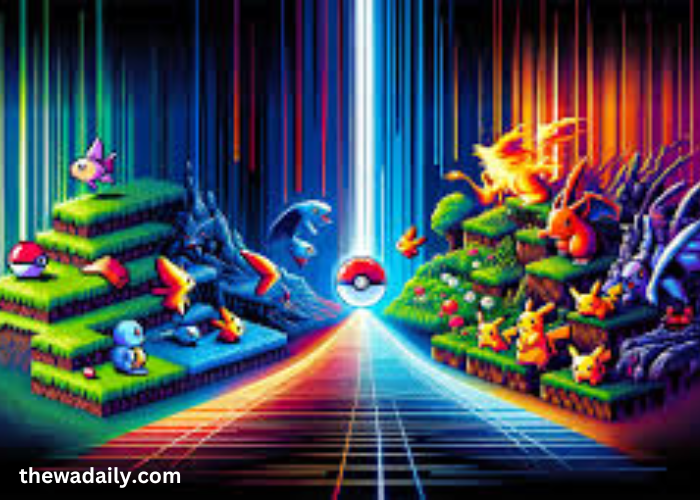When “Pokémon Red” and “Pokémon Green” first hit the shelves in Japan on February 27, 1996, few could have predicted the cultural juggernaut these games would become. Developed by Game Freak and published by Nintendo for the Game Boy, these initial releases sparked a phenomenon that transcended the world of video games, evolving into a global cultural staple. Discover the art of tatsugiri on our website. Explore unique designs and learn about the history and techniques behind this traditional Japanese craft.
The Humble Beginnings
The concept of Pokémon, short for “Pocket Monsters,” was conceived by Satoshi Tajiri. Inspired by his childhood interest in collecting creatures and his fascination with the interconnectedness of nature, Tajiri envisioned a game where players could catch, train, and battle various monsters. The gameplay mechanics were simple yet captivating: players assumed the role of a Pokémon Trainer, exploring the fictional region of Kanto to catch and train Pokémon in order to become the Pokémon Champion.
Despite its simple premise, Pokémon quickly captivated players with its unique blend of RPG mechanics, strategic battles, and a compelling collection aspect. The link cable, an accessory that allowed players to connect two Game Boys, enabled Pokémon trading and battling, fostering a sense of community and competition that was revolutionary for its time.
Expansion and Innovation
The success of the original games in Japan led to their international release as “Pokémon Red” and “Pokémon Blue” in 1998. The games’ success was immediate and far-reaching, spawning an animated television series, a trading card game, toys, and more. The TV show, featuring the adventures of Ash Ketchum and his Pikachu, became a global sensation, introducing millions to the world of Pokémon.
The franchise continued to innovate and expand with subsequent game releases. “Pokémon Gold” and “Pokémon Silver,” released for the Game Boy Color in 1999, introduced 100 new Pokémon, day-and-night cycles, breeding mechanics, and a new region, Johto. These games built upon the foundation of the originals, adding depth and complexity that kept fans engaged.
Technological Advancements
With the advent of new gaming hardware, Pokémon games evolved in both scope and sophistication. The transition to the Game Boy Advance brought “Pokémon Ruby” and “Pokémon Sapphire” in 2002, showcasing improved graphics, double battles, and abilities for each Pokémon. The Nintendo DS era saw the introduction of “Pokémon Diamond” and “Pokémon Pearl” in 2006, which incorporated online trading and battling, making it easier than ever for players worldwide to connect.
The evolution didn’t stop there. The Nintendo 3DS era introduced “Pokémon X” and “Pokémon Y” in 2013, which featured 3D graphics for the first time, mega evolutions, and a new Fairy type. These games demonstrated the franchise’s ability to adapt to modern gaming trends while retaining its core appeal.
Pokémon GO and Beyond
One of the most significant milestones in Pokémon’s history was the release of “Pokémon GO” in 2016. Developed by Niantic, this augmented reality mobile game allowed players to catch Pokémon in the real world using their smartphones. “Pokémon GO” became a cultural phenomenon, drawing millions of players outside to explore their surroundings and catch Pokémon. Its success highlighted the franchise’s enduring popularity and its ability to innovate in new and exciting ways.
The Pokémon franchise has continued to grow with the release of new games, including “Pokémon Sword” and “Pokémon Shield” for the Nintendo Switch, which introduced an open-world area and cooperative multiplayer raids. The upcoming “Pokémon Legends: Arceus” promises to take the series in a bold new direction, blending traditional gameplay with action RPG elements in a historical setting.
Cultural Impact
Pokémon’s impact extends beyond video games. The trading card game remains popular, with competitive play and collector’s markets thriving. The animated series continues to be a hit, with new seasons and movies regularly released. Pokémon merchandise, from toys to clothing, generates significant revenue and keeps the franchise in the public eye.
The franchise’s influence on popular culture is profound. Phrases like “Gotta Catch ‘Em All!” and characters like Pikachu have become ingrained in the global consciousness. Pokémon’s themes of friendship, perseverance, and adventure resonate with audiences of all ages, contributing to its lasting appeal.
Conclusion
From its modest beginnings on the Game Boy to becoming a global phenomenon, Pokémon’s journey is a testament to the power of innovative game design, community engagement, and the timeless appeal of adventure and discovery. As the franchise continues to evolve and adapt to new technologies and trends, its legacy as a beloved cultural icon is assured. Whether you’re a seasoned Trainer or a newcomer to the world of Pokémon, the adventure continues, promising new and exciting experiences for generations to come.
